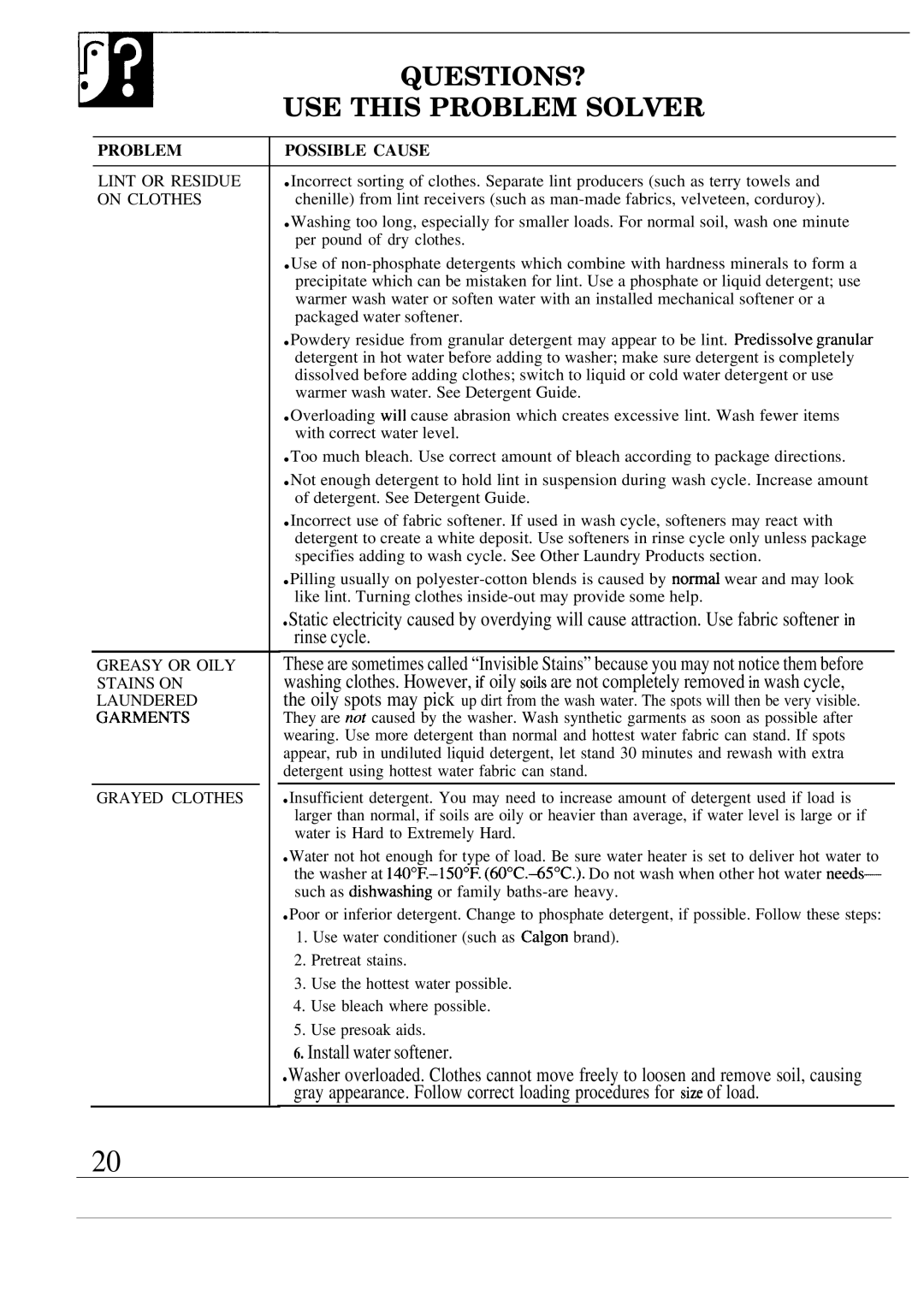
|
| QUESTIONS? |
rUSE THIS PROBLEM SOLVER | ||
| PROBLEM | POSSIBLE CAUSE |
|
| |
| LINT OR RESIDUE ● Incorrect sorting of clothes. Separate lint producers (such as terry towels and | |
| ON CLOTHES | chenille) from lint receivers (such as |
|
|
| ● Washing too long, especially for smaller loads. For normal soil, wash one minute |
|
|
| per pound of dry clothes. |
|
|
| ● Use of |
|
|
| precipitate which can be mistaken for lint. Use a phosphate or liquid detergent; use |
|
|
| warmer wash water or soften water with an installed mechanical softener or a |
|
|
| packaged water softener. |
|
|
| ● Powdery residue from granular detergent may appear to be lint. Predissolve granulm |
|
|
| detergent in hot water before adding to washer; make sure detergent is completely |
|
|
| dissolved before adding clothes; switch to liquid or cold water detergent or use |
|
|
| warmer wash water. See Detergent Guide. |
|
|
| ● Overloading will cause abrasion which creates excessive lint. Wash fewer items |
|
|
| with correct water level. |
|
|
| ● Too much bleach. Use correct amount of bleach according to package directions. |
|
|
| ● Not enough detergent to hold lint in suspension during wash cycle. Increase amount |
|
|
| of detergent. See Detergent Guide. |
|
|
| ● Incorrect use of fabric softener. If used in wash cycle, softeners may react with |
|
|
| detergent to create a white deposit. Use softeners in rinse cycle only unless package |
|
|
| specifies adding to wash cycle. See Other Laundry Products section. |
|
|
| ● Pilling usually on |
|
|
| like lint. Turning clothes |
|
|
| ● Static electricity caused by overdying will cause attraction. Use fabric softener in |
|
|
| rinse cycle. |
GREASY OR OILY |
| These are sometimes called “Invisible Stains” because you may not notice them before | |
STAINS ON |
| washing clothes. However, if oily soils are not completely removed in wash cycle, | |
LAUNDERED |
| the oily spots may pick up dirt from the wash water. The spots will then be very visible. | |
GAWENTS |
| They are not caused by the washer. Wash synthetic garments as soon as possible after | |
|
|
| wearing. Use more detergent than normal and hottest water fabric can stand. If spots |
|
|
| appear, rub in undiluted liquid detergent, let stand 30 minutes and rewash with extra |
|
|
| detergent using hottest water fabric can stand. |
|
|
|
|
GRAYED CLOTHES |
| ● Insufficient detergent. You may need to increase amount of detergent used if load is | |
|
|
| larger than normal, if soils are oily or heavier than average, if water level is large or if |
|
|
| water is Hard to Extremely Hard. |
|
|
| ● Water not hot enough for type of load. Be sure water heater is set to deliver hot water to |
|
|
| the washer at |
|
|
| such as dishwashing or family |
|
|
| ● Poor or inferior detergent. Change to phosphate detergent, if possible. Follow these steps: |
|
|
| 1. Use water conditioner (such as Calgon brand). |
|
|
| 2. Pretreat stains. |
|
|
| 3. Use the hottest water possible. |
|
|
| 4. Use bleach where possible. |
|
|
| 5. Use presoak aids. |
|
|
| 6. Install water softener. |
|
|
| ● Washer overloaded. Clothes cannot move freely to loosen and remove soil, causing |
|
|
| gray appearance. Follow correct loading procedures for sim of load. |
20
